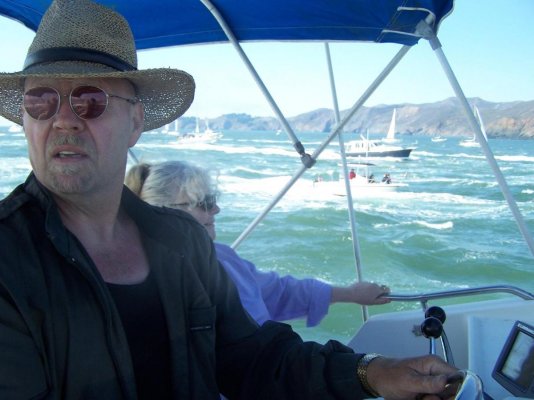Thanks for all the comments, I use the term playing around very loosely, realizing there is never playing when moving boat, especially in open unfamiliar waters.
When I first read your post, I thought you were kidding, but clearly your not. I have almost 1200hrs outside the gate, and believe me, it's NO place to fool around. I see you just finished the USPS piloting course, a great start, but really a beginners course. Prior to heading out the first time, you need to do a lot of homework. The potato patch can be flat as a mill pond when you go out, and two hours later it can be a witches cauldron of steep breaking waves. The so called South channel is a death trap for those who are unaware of it's pitfalls. The main ship channel is in deep water and tends to have the smoothest waters in most states of the tide, but I've seen navy destroyers fighting their way in through the channel too.
Should you find yourself outside when the weather deteriorates, resist the temptation to take a short cut through the North or South channels, and go all the way to the sea bouy before heading in. It may take longer, but it's MUCH safer. Actually, I'd avoid the South channel at all costs.
Long before you venture out, drive up to the Marin Headlands, and spend a lot of time watching the water from the land. Be sure to observe several tide changes. You will see how the seas behave during the different water flow directions and in different parts of the entrance. If you go on a day with a good storm and an Ebb tide, you will see why you never want to be there on a day like that. You would also do well to visit the Army Corps Bay model in Sausalito to get an idea how the tides and currents interplay. My general rule was if the combination of swells and wind waves added up to over 10 feet, I didn't go. Actually many times when it was less, I went out, took a look, turned around and went to breakfast instead. It's just too dangerous to fool around with. Don't forget the fog either. Are you comfortable navigating in "0" visibility? (it can happen quickly) If not, be sure to go on a day where fog is not predicted; but practice with your radar, plotter, and depth sounder every time you go out.
Don't misunderstand me, heading out into the ocean is great, it set the stage for the remainder of my life, and I love it, but it's no place to fool around and learn at the school of hard knocks. You only have to be wrong once. Be sure to monitor the weather forecast as much as a week in advance to get a feel for the trend, not just the days forecast. Make sure your boat is in top shape too. Are your fuel tanks clean? You might have been boating in the delta for years with out a problem, but one trip into the ocean can mix up all the junk at the bottom of the tank and quickly clog your filters leaving you dead in the water. Do you carry spares? Do you know how to bleed your engine's fuel system (in a rolling seaway)?
"We do make safety of first concern, wearing inflatable life jackets, whenever we are outside the boat underway, having communications devices fully charged and repeating commands back and forth, to ensure our messages are well recieved."
This quote makes me think your main plan if things go wrong is to call for help. While calling the C/G should be your first action if you get in trouble, you need to do everything in your power to avoid getting in trouble in the first place. Do you have a life raft, EPIRB, survival suit for all aboard, and current flares? Have you run abandon ship drills, fire drills, MOB drills?
Heading out the gate is a wonderful experience and it's not to be missed, but don't go until you have done a lot of homework and research, the weather looks good and the boat is in top condition.
Going out with a seasoned skipper the first few times would be a great idea too. Above all, enjoy the experience and have a safe time..........Arctic Traveller
Oh Yea, Bay Ship is the place to go for prop work, tell Jeff I said Hi. (I worked there for years)
 Looking for answers so don't be shy
Looking for answers so don't be shy Looking for answers so don't be shy
Looking for answers so don't be shy






